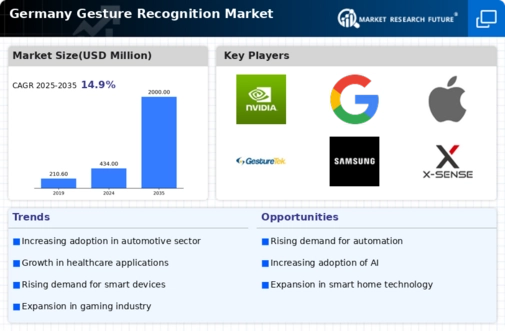Rising Adoption in Automotive Sector
The gesture recognition market in Germany is witnessing a notable rise in adoption within the automotive sector. As manufacturers strive to enhance driver safety and convenience, gesture recognition technology is being integrated into vehicles for functions such as infotainment control and navigation. This trend aligns with the broader movement towards smart and connected vehicles, where intuitive interfaces are becoming essential. The automotive gesture recognition market is expected to grow at a CAGR of 30% over the next five years, indicating a robust opportunity for the gesture recognition market. As consumer expectations evolve, automotive companies are likely to prioritize the development of gesture-based controls, thereby driving innovation and growth in this segment.
Growing Demand for Contactless Solutions
In the context of the gesture recognition market, the demand for contactless solutions is on the rise in Germany. This trend is largely driven by consumer preferences for hygiene and convenience, particularly in public spaces and retail environments. As businesses seek to enhance customer experiences while minimizing physical contact, gesture recognition technology offers a viable solution. The market is projected to reach a valuation of €1 billion by 2027, reflecting a growing acceptance of touchless interfaces. This shift not only benefits consumers but also encourages businesses to adopt innovative technologies, thereby propelling the gesture recognition market forward. The potential for widespread adoption across various sectors, including hospitality and transportation, further underscores the importance of this driver.
Increased Investment in Smart Home Technologies
The gesture recognition market in Germany is significantly influenced by the rising investment in smart home technologies. As consumers increasingly seek automation and convenience, gesture recognition systems are being integrated into smart home devices, such as lighting and security systems. This integration enhances user interaction, allowing for seamless control through gestures. The market for smart home devices is expected to grow at a CAGR of 20% over the next five years, indicating a robust opportunity for the gesture recognition market. Companies are likely to focus on developing intuitive gesture-based controls that cater to the evolving preferences of tech-savvy consumers, thereby driving further growth in this segment.
Technological Advancements in Sensor Technology
The gesture recognition market in Germany is experiencing a surge due to rapid advancements in sensor technology. Enhanced sensors, such as depth cameras and infrared sensors, are becoming increasingly sophisticated, allowing for more accurate gesture detection. This technological evolution is crucial for applications in sectors like automotive, healthcare, and gaming, where precision is paramount. The integration of these advanced sensors is expected to drive market growth, with projections indicating a compound annual growth rate (CAGR) of approximately 25% over the next five years. As companies invest in research and development, the gesture recognition market is likely to witness innovative solutions that cater to diverse consumer needs, thereby expanding its reach across various sectors.
Expansion of Virtual and Augmented Reality Applications
The gesture recognition market is poised for growth in Germany, particularly due to the expansion of virtual and augmented reality (VR/AR) applications. Industries such as gaming, education, and training are increasingly adopting VR/AR technologies, which rely heavily on gesture recognition for user interaction. This trend is expected to create substantial opportunities for the gesture recognition market, as developers seek to enhance user experiences through intuitive controls. The VR/AR market is projected to reach €5 billion by 2026, suggesting a strong correlation with the growth of gesture recognition technologies. As more companies invest in immersive experiences, the demand for sophisticated gesture recognition systems is likely to increase, further propelling market dynamics.






















Leave a Comment